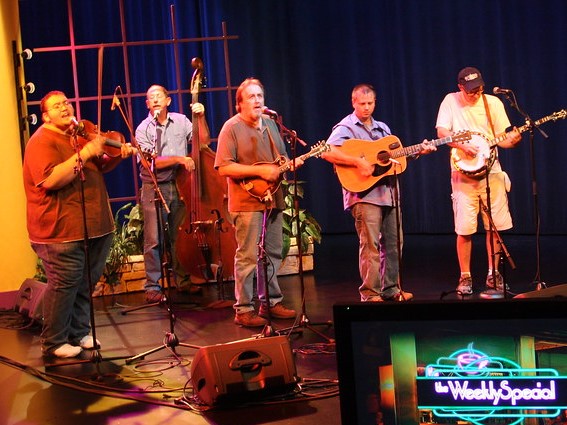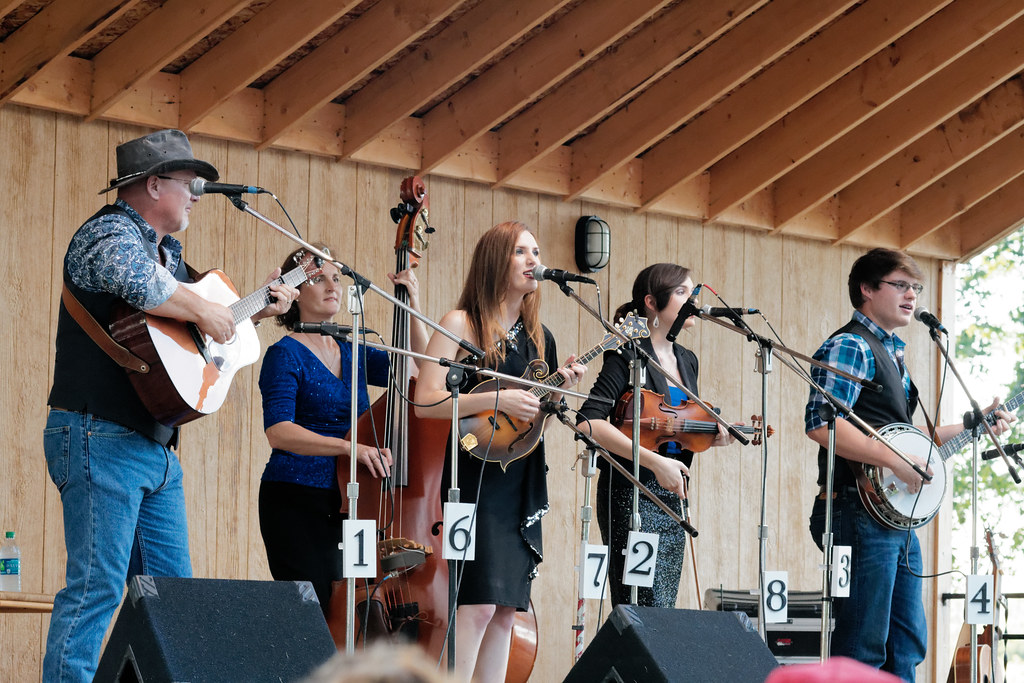The World of Panem
Interpreting Society, Geography, and Characters of the Hunger Games
The Covey’s Mountain Music and the “High, Lonesome Sound”

(Note: Spoiler Alert for The Ballad of Songbirds and Snakes)
(Author’s Note: This is a draft excerpt from my future book focusing on the culture of District 12, still taking shape as of this writing.)
One of the southern Appalachian region’s most distinctive cultural forms is found in its music. While Collins incorporated some hints of the region’s musical tradition in the original Hunger Games trilogy, it did not exactly leap off the page and grab us in the midst of all the darkness and rebellion going on. All that changed with her Prequel, the title of which even reflects the cultural importance of the ballad to this region. For music enthusiasts like me, it was a treat to be introduced to the Covey in chapter 23. Though we had been introduced to Lucy Gray and some of her singing earlier in the story, it is in this chapter where Collins goes “full Covey” and provides us with a front-row seat to one of Appalachia’s most enduring cultural legacies.
Just as some 200 District 12 peacekeepers and local citizens enjoyed a Saturday night concert at the Hob by this talented musical group, I imagine readers like me also appreciated taking a breather from the otherwise dour and tragic Hunger Games theme to unwind and get our toes tapping. Even Coriolanus couldn’t resist the happy atmosphere as the Covey took the stage. He “found his hands joining in” as the audience called for the show to begin. As the Covey let loose with their first number, Coriolanus “felt his heel tapping out the beat” as “his girl,” Lucy Gray prepared to sing. Upon further researching the Covey this summer, I have discovered that this “toe-tapping” style was no accident on Suzanne Collins’ part. Indeed, nothing Collins writes is an accident, but instead is full of calculation and purpose. Such is the case with the Covey’s musical style.
Although Collins never directly mentions the Covey’s style or genre, some form of early country music would be a good first guess. Throughout the Prequel, Collins includes a sampling of actual American songs—or adaptations of them—that had become popular prior to World War II and generally represent the early country genre—originally referred to as “hillbilly music” before the recording industry adapted the less stereotypical “country” term. Early country songs adapted for Lucy Gray include “Keep on the Sunny Side,” and the mournful “Valley Song” adapted from a traditional American folk-turned-country tune, “Down in the Valley” (also known as “Birmingham Jail”).
For its part, however, the Covey is not a country band. The Covey’s performance style and instrumentation described in the Prequel allow us to narrow down their genre even further. What we have in the Covey is a rather traditional example of an Appalachian bluegrass band. For those not majoring in music history, it is important to make the distinction here between genuine bluegrass style from its more general “cousin” known as “country” music. What Collins provides here is not country, but is rather “bluegrass with a vengeance,” as I like to say.
Cutting to the chase, I have identified the Covey’s likeness to one specific—and historically significant—bluegrass band whose original membership from 1939-1942 included the precise instrumentation of the Covey: mandolin, guitar, string bass, and fiddle. This seminal band represented the historical origin of the “bluegrass sound”. Known as Bill Monroe and the Blue Grass Boys, Monroe himself is credited as the “Father of Bluegrass music”. In brief for now, his early band had first “wowed” the managers of the Grand Ole Opry in 1939 with an up-tempo rendition of a more traditional song, “Mule Skinner Blues”. The Blue Grass Boys were hired on the spot for a lifetime commitment to the Opry, where they were featured performers for half a century (when not touring the eastern half of the U.S like the Covey). Monroe’s primary instrument was the mandolin, and he was credited with elevating that once-popular instrument to the occasional lead role of many bluegrass bands, including his own. Tam Amber would be proud! (See this site for an image of Monroe’s early group with the same instrumentation as the Covey. Also includes sample songs. Notice how they are all gathered around the mic, similar to the Covey.)
Interestingly, the use of the term “bluegrass” to define their new music style would not be used in print until more than a decade after their showstopping premier performance at the Opry in 1939. It turns out that Monroe had originally named his trend-setting band after his home state of Kentucky’s nick name, the Blue Grass State.

Strangely, the Covey instrumentation does not include a banjo, a traditionally African-American instrument (with origins in Africa) that became a quintessential feature of bluegrass music (see this informative 4-minute video on the African heritage of the banjo and its development in America). My only possible explanation at this time is that Bill Monroe’s original Blue Grass Boys likewise did not employ a banjo until he actively sought to add one in 1942. After that, it would become fairly standard to include a banjo within bluegrass bands. This is why the closest approximation I can find to the Covey is—quite precisely—Bill Monroe and the Bluegrass Boys as they existed in their earliest formation, between 1939 and 1942 as mentioned above. Given the propensity for Suzanne Collins to adopt a variety of early twentieth-century cultural and economic traits for her version of District 12, it would not surprise me if she decided specifically to model the Covey on the Blue Grass Boys of this era — including a possible “nod” to Bill Monroe with the fast-fingered picking of Tam Amber. However, this all remains speculation on my part, as I have absolutely no evidence that this was how she was thinking. Still, the similarities here are uncanny, so I’m running with it here.
The Covey and that Bluegrass Sound
Let’s take a sample look at the Covey’s own style. While Collins often makes readers guess and ponder her hidden meanings, we are fortunate in this case that she provides quite a thorough description of a typical Covey performance at the Hob (and yet another follow-up at the Peacekeeper base!).
With geographical roots that are southern, rural, African-American, Anglo-American, and Scots-Irish, bluegrass is first distinguished through its rather standard instrumental mix as mentioned earlier. The core of a typical bluegrass band usually features five different and complimentary “acoustic,” stringed instruments—those whose sounds are not enhanced or modified with electronic amplification. Thus, an electric guitar would not qualify for the “traditional bluegrass” genre, and traditional bluegrass fans will do anything they can to keep percussion sets away from a bluegrass performance (though this is more common today). A typical bluegrass group would consist of five non-amplified, string instruments, namely the mandolin, guitar, fiddle, five-string banjo, and upright bass, according to historian Stephanie Ledgin in her book, Homegrown Music: Discovering Bluegrass (2004). Another source defines a bluegrass group as needing at least four musicians and instrumentation that would include acoustic guitar, an upright bass, and banjo, “though these instruments are not mandatory,” given that the fiddle, mandolin, and resonator guitar (Dobro) are common as well (That High, Lonesome Sound). As one might expect, this is not a hard-and-fast rule for bluegrass bands, but this is the expected core of instrumentation.

The Covey fits this pattern almost precisely, as Maude Ivory introduces their members at the start of their show. Namely, Tam Amber arrives on stage first with his mandolin, followed sequentially by Clerk Carmine on fiddle, Barb Azure on base, and none other than Lucy Gray Baird (“fresh from her engagement in the Capitol”), with her guitar. We don’t know if Maude Ivory plays an instrument or not at this point, as she may focus on vocal performance at her young age. Beyond this instrumental makeup, there is no indication of additional current instruments, such as percussion, brass, or use of amplification—mirroring a pretty standard bluegrass group.
Beyond the current Covey, there was one additional member we also know about, namely Billy Taupe. His is a good example of how bluegrass band membership can change and shift with time. Not only is his name representative of the Covey lexicon—first name for a ballad, second for a color—but he also seems to walk around randomly carrying his former instrument that he once played with the group. This instrument is clearly a significant part of his own identity. At the end of their Hob performance, it is a somewhat inebriated Billy Taupe who approaches the stage to confront Lucy Gray and all of the Covey. As Collins narrates, “Over one shoulder hung a boxy instrument with part of a piano keyboard along one side.” Later in the story, the bulky instrument appears once again after Coriolanus and the Peacekeepers take Mayfair home. As Coriolanus leaves with his peers to head back to base, he was distracted by the sound of a “soft, mechanical wheeze”. A light from the house revealed Billy Taupe, who held his instrument, “the source of the wheeze, against his chest”. (Chapter 24). Given these descriptions, Billy’s instrument is most certainly the accordion. And part of him already misses not playing with his counterparts. As a true musician might argue, he claims “You’re all sounding thin. You’re sounding thin,” as one hand slaps his instrument. My point here is that, like traditional bluegrass groups, the Covey’s instrumentation and membership can change and adapt to circumstances over time. In fact, Bill Monroe’s group included an accordion player for a limited time (a woman named Sally Ann Forrester: 1943-46), and instruments such as the accordion, harmonica (mouth harp), and others occasionally show up in bluegrass bands. However–perhaps like Billy Taupe himself–these are supplemental and not fully necessary for bluegrass instrumentation.
As for the Covey’s leader, Lucy Gray opens the story’s first performance with an “old song” while the rest are “gathered in a close half circle around the mic”. This is standard practice for bluegrass performers, to utilize the mic for singing songs with two, three, or even four-part harmonies. Because these bands are typically acoustic with no electronic amplifiers, the mic actually plays a pivotal role in the group’s performance routine and projected sound. While electronically enhanced instruments are frowned upon, a lone mic on stage is not only acceptable but plays a critical role in a standard bluegrass performance. The mic serves as a minimalist though critical “sound reinforcement system” to make instruments and singers more audible to larger audiences (Ledgin 2004). In fact, the audience tends to demand this practice, as these avid listeners and fans are eager to pick out every instrument and vocal performer. As Smith describes, an important bluegrass skill for any serious musician is the ability to “maintain the proper relationship, spatially and thus aurally, with the rest of the band and the microphone.” (Smith 1965).
As for vocal style and pitch, the “high, lonesome sound” associated with bluegrass is not so much “Appalachian” in origin, but rather the legacy of the country singer, Jimmie Rodgers. He is considered the first country music star from the 1920s (along with the Carter Family) and is credited for establishing the popularity of the “blue yodel”. He further helped integrate the blues into country music and directly affected the eventual bluegrass sound (Perryman 2013). In fact, Bill Monroe adapted several of Rodger’s songs for his first recordings with the Blue Grass Boys and made good use of the Jimmie Rodgers yodel within his vocals. Most prominent was the very song that Monroe performed with the Blue Grass Boys during their premier at the Grand Ole Opry in 1939, Mule Skinner Blues. The song had previously been co-written by Jimmie Rodgers and titled simply Blue Yodel #8, revealing the yodel’s prominent role in the song. Monroe modified it and transformed it into a bluegrass favorite.
Further, the contribution of black musical traditions to the style of Jimmie Rodgers and later bluegrass music should not be understated. Yodeling had already been ingrained within African folk music, and traces were found within the field-hollers of African-Americans. The tradition likely influenced the singing of Jimmie Rodgers, who was raised in a predominantly black community. His style also incorporates that of the blues, a strong black influence (Phillips 1991). With so much historical mixing of such stylistic traits, bluegrass and its “high, lonesome” qualities essentially represent an ongoing cultural exchange among peoples from three continents: Europe, Africa, and North America. Bill Monroe just happened to be the one to creatively blend these elements into his own unique style that would eventually become known as bluegrass.
To conclude here, these are a few of the characteristics that define bluegrass music as a distinctive genre and why the Covey appear to epitomize this style more than any other. I would not be surprised if the future Lionsgate film features some pretty snappy bluegrass tunes to supplement the more traditional country numbers and ballads of Lucy Gray and her Covey family. I do hope the movie producers provide the Covey with plenty of “air time,” as their music should provide for one of the delightful highlights of the film adaptation! I would further not be surprised to see yet another generational resurgence of interest in bluegrass music and maybe even the otherwise obscure mandolin (please see my related post, Tam Amber’s “Teardrop” Mandolin.)
Want a taste of bluegrass video?
Watch this to see a close approximation to the Covey’s performance style as described in The Ballad of Songbirds and Snakes: A sample performance of Bill Monroe and the Blue Grass Boys, around the late 1960s or early 70s for a TV show called “The Country Place”. Notice how musicians come in and out of the lead role, taking turns. The vocals are gathered around a single mic, like the Covey. This also speaks to the diverse origins of bluegrass music, the repertoire for which includes traditional gospel music such as the first number here. Also, an excellent example of the so-called “high, lonesome sound” characteristic of bluegrass harmonies.
Here’s a fun 15-minute sampling of a professional bluegrass performance, a one-time concert of with bluegrass/country stars including Ricky Skaggs (who tears it up on the mandolin!), Travis Tritt, Vince Gill, Patty Loveless, and the “great” Earl Scruggs, the father of the 3-finger roll picking style on the banjo (who got his start with the Blue Grass Boys in 1945!). You’ll find numerous other bluegrass videos like this as well.
Example of modern-day, 4-member bluegrass band (with banjo replacing mandolin in this case): Southern Raised Bluegrass Band performs “Orange Blossom Special,” a bluegrass classic (along with a creative music video and some other integrated songs!)
A traditional, 6-member bluegrass group with standard bluegrass instrumentation (with two fiddles and banjos), the Augusta Bluegrass Women, performing during Bluegrass Week (2014) at the Augusta Heritage Center of Davis and Elkins College, WV. A great example of a local band (not necessarily professional musicians) having fun with their music and performance (like the two local bands pictured above). This is similar to the numerous bluegrass festivals that are held every year and attract untold numbers of local bluegrass bands and enthusiastic audiences.
Feature post image: Bill Monroe performing on his Gibson F-5 mandolin in 1989, 50 years after his debut at the Grand Ole Opry. (Courtesy of Barry Brower, Creative Commons)
REFERENCES:
Ledgin, Stephanie. 2004. Homegrown Music: Discovering Bluegrass. (ABC-CLIO Publishing).
Perryman, Charles. 2013. Africa, Appalachia, and Acculturation: The History of Bluegrass Music. West Virginia University dissertation.
Phillips, John. 1991. “The African Heritage of White America,” in Africanisms in American Culture, ed. Joseph E. Holloway, (Bloomington: Indiana University Press).
Smith, Mayne. 1965. An Introduction to Bluegrass. The Journal of American Folklore, Vol. 78, No. 309, pp. 245-256.
That High, Lonesome Sound: A Guide to the Instruments in Bluegrass. Accessed 03 August, 2020.



Pingback: Tam Amber’s “Teardrop” Mandolin – The World of Panem
Pingback: The Valley Song as Country Music Exemplar – The World of Panem